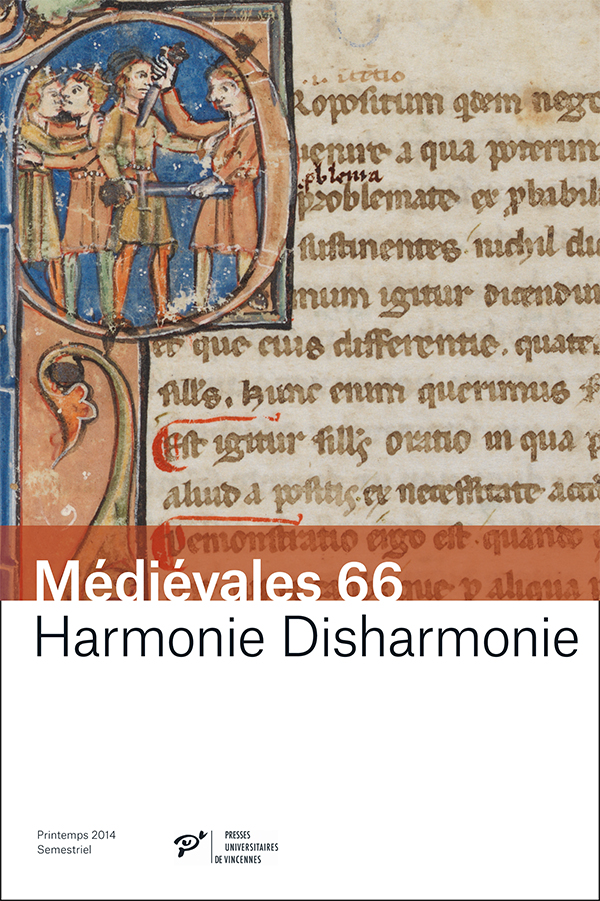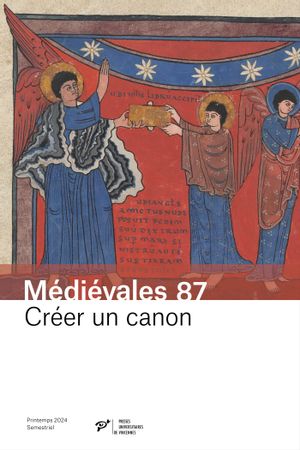Amy Heneveld
Concordia Discors : The Harmony of Medieval Writing
This paper examines the importance of the expression concors discordia, or discordia concors, to medieval literary aesthetics. Harmony, the last allegorical figure to speak in Martianus Capella’s De Nuptiis Philologiea et Mercurii, offers a model of musical and literary unity which is at once pleasing and instructive, beautifully complex. The words concordia and discordia, from their allegorical figurations to their various entwined appearances, suggest a path to follow from antiquity to medieval conjointure, from Empedocles to Alain of Lille, Geoffroy of Vinsauf and Chrétien de Troyes.
Welleda Muller
Representations of the Harmonia Mundi in gothic manuscripts and choir stalls in France. King David tuning his harp and angel musicians
Harmonia Mundi is an essential notion in traditional medieval culture. The dual idea that the world is governed by a divine order and that the rotation of the spheres produces a harmonic sound inaudible to human ears is present throughout medieval society and for the intellectuals in particular. This idea is not only discussed in texts by scholars, but it is also represented in pictures. Thus, the multitude of angelic musicians mainly playing stringed instruments, is certainly the image of the music of the spheres, especially in the choir stalls and manuscripts, two artistic media linked to the liturgical chant whose practice allows find the divine harmony of Creation. Besides the angel musicians, images of Harmonia Mundi, a model is presented to encourage the faithful in their own quest for harmony: it is King David tuning his harp, thus highlighting the need for adjustment the word order. However, the fifteenth and sixteenth centuries were a turning point that saw a change in worldviews, which is reflected in the imagery. The angelic musicians disappeared gradually from the carved choir stalls and painted manuscripts to be replaced by putti who have no function; at the same time, the heavens were empty of spiritual substances which allowed orbs to move in medieval conceptions of the world.
Philip Knäble
Dance and The Harmony of the Spheres in the Medieval Clerical Context
The Church, especially the medieval Church, is known as an institution completely opposed to dancing. Nevertheless there existed some cathedral churches, for example at Auxerre, where even the canons danced in the church during religious feasts. This article discusses the ecclesiastical dances in relation to the reception of Neo-Platonist philosophy and its concept of the harmony of the spheres at the cathedral schools. Viewing the dance as a performative expression of the harmony of the spheres the canons incorporate the dance as a practice of devotion.
Amélie Bernazzani
“Ad imaginem et similitudinem Dei” ? The characters that surround the dead Christ in harmony with the divine ?
It is through the Incarnation that God gives men a chance to return to the era of the divine likeness. Through Christ, he is indeed the appearance of carnal men – sinners – and goes imitable. Like Christ, so it regains some of the harmony that reigned in the Garden of Eden. The imitation of Christ is therefore the sine qua non of salvation obtain redemption is impossible without complying with Christ through acts and, especially, by the thought : “I am crucified with Christ [Paul says to the Galatians 2, 19-20] and it is no longer I who live, but Christ who lives in me”. We propose to show that in the pictures, this association between ugliness and sin is common. Thus, compared to Christ, executioners and the bad thief are ugly and deformed : one should serve as models for the spectator, and the other as “contre-figures”.
Ludivine Jaquiery
The aesthetic of “entanglement” in the portraits of the young Lancelot and of Claudas de la Terre Déserte in the prose Lancelot
The Poetic Arts have recommended models for describing characters. However, these models are not fixed and allow anyone who wishes to portray a character to renew them. This study offers a comparative portrait analysis of the young Lancelot and Claudas de la Terre Déserte as they appear in Lancelot en prose. The author of this novel develops the portraits through notions of « entremêlement » [entanglement] of the components of the two characters and of « mesure » [measure] of their proportions. If measure is usually a source of harmony, the manner of describing the two characters proves rather the opposite. The results differ for Claudas or Lancelot when « entremêlement » [entanglement] is considered. The former is ambivalent, double, whilst the latter transcends the contradictory elements that compose him by integrating them. Their merger increases the value of each another.
Pascale Tiévant
The Dwarf, a Disproportionate Figure in Profane Manuscript’s Illuminations of XIVth and XVth Century France
The dwarfs, represented in the illuminations of the secular manuscripts of the fourteenth and fifteenth centuries in France, are characterized by their disproportionate “hugeness”. Beyond the fact of their height, the images project a figure of “otherness” which does not always rely on the disharmony that a number of texts would suggest. Of course, we do find some pictures of truly uncouth dwarfs, serving the cause of the allegory of vices and those of the warlike pygmies of Antiquity. However, this is not the case for all of the illuminations, collected in the main from the manuscripts of “Matière de Bretagne” and of France, that portray sometimes tetchy or vindictive little personages, but nonetheless ones which on analysis, reveal rather positive figures, with values and a place in the world’s harmony.
Thibaut Radomme
Guillaume Crétin and the Déploration sur le trépas de Jean Ockeghem : Choruses, Hearts and Poetry
This article offers a study of the poem Déploration sur le trépas de Jean Ockeghem, written by Guillaume Crétin at the extreme end of the fifteenth century, in a double perspective : the representation of choruses’ harmony and hearts’ disharmony on one hand, and the problematisation of the topos of author’s humility on the other hand. After a brief introduction, in which I give a contextual background about the concepts of harmony and disharmony as well as a general overview of the poem, the first part of the article deals with the first perspective of reading : if choruses’ harmony seems at first sight to contrast with hearts’ disharmony, borders are in fact blurred and choruses are contaminated by the disorder of feelings, which results in the rejection of happiness that characterizes funeral singing. In the second part of the article, I want to examine the position of inferiority in which Guillaume Crétin puts himself as an author. Indeed, whilst he claims to be unable to write the poem that he has been asked to compose and calls for the help of his illustrious predecessors and famous contemporaries, he recognizes the superiority of music over poetry. However, the author seems to deceive the expectations of the reader and, through an ingenious mise en abyme and by exploiting the performative dimension of the poem, to crown himself as the prince of the poets.
Marjorie Burghart
Signata de mea marcha : Merchants’ Marks in the Chambéry Toll Accounts (fifteenth century)
At the beginning of the fifteenth century, the especially detailed accounts of the Chambéry toll (Savoy, France) sometimes bear a sketch of the merchants’ marks that were drawn on the balls, to justify their exemption from the toll rights. This corpus of about sixty different marks offers an insight into their formal typology (the cross, its support, and letters of the alphabet are the main recurring graphical elements), but also their evolution, and even in one exceptional case the similar graphical features of a merchant’s mark and another identification device, his signature. A series of letters, linked to the accounts and requesting exemption from the toll rights, sheds further light on the wide range of practical uses of the merchants’ marks.
Marcelo Cândido da Silva
The “Moral Economy” under the Carolingians (end 8th-9th c.)
The object of this article are the measures taken by the Carolingian princes to confront the alimentary crises, as found in three capitularies published by Charlemagne between the end of the 8th and the beginning of the 9th century: the Capitulare Episcoporum (c.779), the Capitulaire de Francfort (794) and the Capitulaire de Nimègue (806). At first glance very disparate, the measures anticipated by these texts were not, up until now, object of an analysis as a single group. Through this group viewpoint, we will attempt to go beyond the acknowledgment of the “despair” that would have inspired them, and ponder on whether or not there could have been a common guideline in the treatment of the problem of famine under the Carolingians.




